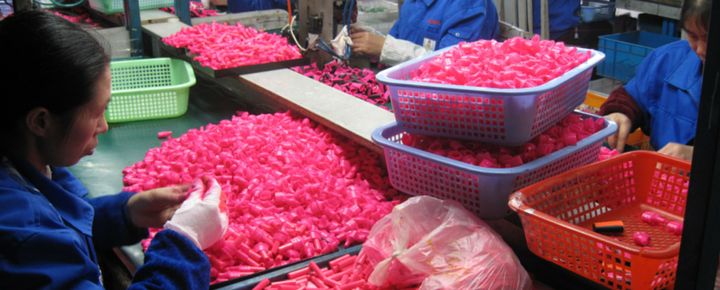
Tragically, the human slave trade is alive and well and lurking in the shadows of global manufacturing supply chains. One of the biggest challenges faced by those who seek to eradicate human slavery is the many masks behind which it hides, each of which confuses the issue. "Forced labour," "bonded labour," "indentured servants," "human trafficking," and "child marriage" are all aspects of the same insidious practice, and entities of all types are confounded by a worker category that doesn't explicitly say, "slave." Ergo, international corporations that access global manufacturing sectors should actively address the possibility that aspects of their supply chains might be built on slave labour.
A Long and Entrenched History
Records of human slavery have been around for as long as humans recorded their activities. The world's first cities in Mesopotamia were built by slaves, as were the Pyramids at Giza, and much of the ancient Greek and Roman civilizations. Slavery comes in many forms, such as "debt" slavery, where a person remains enslaved to another until a debt is repaid, if that ever happens. In some countries, anyone who wasn't of the higher classes was automatically a slave, as were their children. Generational slavery occurred when subsequent generations assumed the "obligations" of their ancestors and remained the slaves of the descendants of their captors.
It wasn't until 1781 that any political entity addressed the moral and ethical implications of slavery when the Holy Roman Emperor Joseph II abolished the practice in his Austrian Habsburg provinces. His act launched a wave of abolitionist activities that carried through the 20th century, and continues on today, in the 21st.
Modern Slavery
Across the globe, modern day slavery continues to exist, as governments ignore the plight of thousands of their constituents, or actively engage with wealthy citizens known to condone the practice for profit. Myanmar is a terrible example for its condemnation of its indigenous Rohingya people, to whom it refuses to grant citizenship and against whom it tolerates intense hate speech and human rights violations including slavery that border on genocide.
Other Southeast Asia countries are "famous" for their child-sex trade. In brothels in Cambodia, children as young as four are sold by their impoverished families to "work" in "good jobs." Often, and compounding the tragedy, these children are told that the money paid to their families was an "advance" on their future earnings and that they must now continue to work to "repay" that advance.
Forced labour is also a major form of today's slave trade, where intimidation and threats exploit workers. People of all ages, including children, are intimidated or threatened to work for little or no pay and in horrendous conditions. Child labour is rampant in many parts of the world, where children as young as five years are forced to work eight to twelve hours a day at menial tasks. One global slavery watchdog group estimates that there are more than 45 million people enslaved in 167 countries today.
Slaves in Supply Chains
While many international producers are appalled by the notion of slavery, they may not be aware that it exists within the supply chains they access for their production needs. Today's global manufacturing community relies on the contributions of sometimes hundreds of suppliers to produce their lines of products. Those suppliers are often at the end of a long line of contributors, and their production methods are essentially invisible to entities further up the chain. Especially when the sourced element is an aspect of the product's raw materials, cotton in a T-Shirt, for example, identifying the exact farm from which that cotton was harvested might be impossible, and the slaves it maintains remain hidden within the supply chain. Cultures and traditions may also prohibit suppliers from revealing the circumstances of their labour force. Still others regard their enslaved workforce as less than human under any circumstances and see no reason to declare them as anything other than a corporate asset, having the same value as a shovel or a tractor.
The Global Problem Needs a Global Response
Manufacturers who value their corporate reputation are appropriately cautious about the possibility of slavery in their international supply chains. In fact, a recent survey indicated that more than 70 percent of companies suspect that their supply chains might have slaves within them. Many of these companies might be fatally damaged by revelations to consumers that slave labour contributed to the production of their goods, so they take precautions internally to seek out and avoid the possibility of slave activity. They also engage externally with associations that focus on revealing and eradicating this horrific practice.
However, even with the most careful scrutiny and in countries with strong anti-slavery laws, many companies are still at risk of inadvertently engaging with slave labour, especially if they don't have well trained "eyes" searching the length of their supply chains. For these companies, hiring a "supply chain transparency service" can ensure that they not only avoid contact with the despicable practice but also that they come into or remain in compliance with their national laws against engaging with slaveholders. Many companies can prove their diligence in avoiding slave-based labour because they rely on locally based experts who know what the risks are, know what to look for, and who can see past the facade to the truth of the supplier. For these corporations, ensuring a slave-free labour force also ensures a long-lived and healthy enterprise.
Because of the complexity and competitiveness of today's commercial markets, it is more imperative than ever that every operation maintains its vigilance against slavery in its supply chains. When directly or indirectly sourcing our supplies in China or Southeast Asia, it is not only our moral obligation as human beings but also imperative to our continued business success that we ensure that our supply chains are slave-free.
You can read more about how to deal with risk in the supply chain here.
